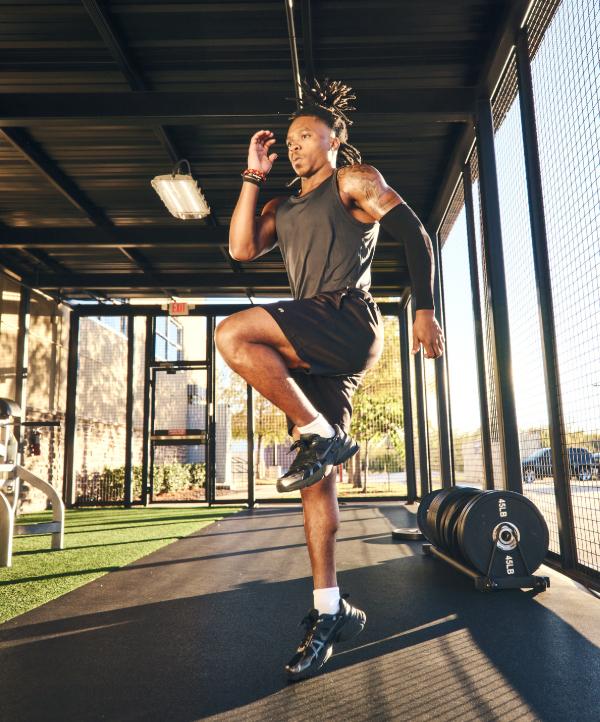STRENGTH TRAINING FOR SENIORS: BEGINNER-FRIENDLY EXERCISES FOR BALANCE & INDEPENDENCE
Fitness Tips
Oct 13, 2025 • 5min read
Aging doesn’t mean slowing down, it means training smarter. Strength training for seniors is one of the most effective ways to stay strong, mobile and independent. Whether you’re brand new to lifting weights or just returning to fitness, building muscle and balance can help you move confidently through everyday life. This guide is designed to help you start safely and progress gradually, with approachable routines that support long-term health and independence.
WHY STRENGTH TRAINING MATTERS FOR SENIORS

Strength training helps seniors maintain independence by improving muscle mass, bone density and balance.
It’s more than just lifting weights. Strength training supports everyday function and long-term wellness.
Key benefits include:
- Improves bone density to reduce the risk of fractures
- Builds muscle to make daily tasks easier
- Enhances balance and stability to lower fall risk
- Increases energy levels and supports mobility
- Promotes long-term independence
GETTING STARTED: SIMPLE STRENGTH TRAINING FOR SENIORS
The best way to start strength training as a senior is to begin light, focus on form and stay consistent.
You don’t need to lift heavy to feel stronger. Starting with just your body weight or a light set of dumbbells is more than enough to build a solid foundation. What matters most is moving with control, listening to your body and showing up regularly. Over time, those small steps lead to big improvements.
Light Weight Training for Seniors
Use manageable resistance to prevent strain.
- Begin with 1–5 lbs dumbbells or resistance bands
- Move at a steady, comfortable pace. Controlled movements protect your joints and help you build strength safely.
- Complete 2–3 sets of 10–12 reps per exercise
Body Strength Exercises Without Equipment
These simple moves build real strength and balance.
Wall Push-Ups or Countertop Push-Ups
Wall or countertop push-ups are a great way to build upper body strength without putting too much pressure on your wrists or shoulders.
How to do it:
- Stand facing a wall or sturdy countertop.
- Place your hands shoulder-width apart, slightly below shoulder height.
- Step your feet back just a bit so your body forms a straight line.
- Bend your elbows slowly, bringing your chest toward the wall or counter.
- Press back to your starting position.
Tip: Keep your back straight and engage your core—don’t let your hips sag.
Chair Squats
Chair squats help strengthen your thighs, glutes and hips—all key muscle groups for safe walking, standing and getting up from a seat.
How to do it:
- Stand in front of a sturdy chair with your feet about hip-width apart.
- Slowly lower your hips as if you’re going to sit down.
- Lightly touch the chair with your hips—don’t plop down!
- Push through your heels to stand back up.
Tip: Keep your chest lifted and knees behind your toes throughout the movement.
Standing Calf Raises
Calf raises improve ankle strength and balance, which helps reduce your risk of falls.
How to do it:
- Stand tall behind a chair, lightly holding the back for support.
- Raise your heels slowly so you’re standing on the balls of your feet.
- Hold for a second, then lower your heels back to the floor with control.
Tip: Try doing these near a wall for added support if you’re working on balance.
SAFE WEIGHT TRAINING TIPS FOR SENIORS AT THE GYM

Strength training at the gym can feel intimidating at first, but it’s one of the best places to build confidence and get full-body results. If you’re new to using equipment, start with machines—they help guide your movements and add stability so you can focus on form and safety.
Tips for training safely at the gym:
- Begin with light resistance and learn proper form
- Focus on big muscle groups: legs, back, chest, arms
- Keep workouts short and consistent (20–30 mins)
- Ask a team member or Personal Trainer for help
HOW OFTEN SHOULD SENIORS DO STRENGTH TRAINING?

2–3 times per week, with rest days between sessions, is ideal for most seniors. Recovery is just as important as the workout itself. You want to challenge your muscles, not overwork them.
Recommended routine:
- 2–3 strength sessions weekly
- At least one rest day between workouts
- Mix in light cardio, flexibility and balance work
- Increase reps or weight gradually
- Adjust intensity based on how you feel
EXAMPLES OF SAFE SENIOR WORKOUTS WITH WEIGHTS
If you’re ready to add some resistance to your routine, these light dumbbell and resistance band exercises are a great place to start. They target major muscle groups, improve balance and keep your joints safe. No fancy gear is needed; it’s just a few basic moves and a little space to move.
Here are a few simple exercises to try (aim for 2 sets of 10–12 reps for each):
- Seated dumbbell curls and overhead presses
- Resistance band rows and chest presses
- Chair squats with light weights
- Core moves like seated twists or standing marches
Don’t forget: Warm up for 5 minutes and cool down with gentle stretches to protect your muscles and joints.
SAFETY TIPS FOR SENIOR STRENGTH TRAINING
Focusing on form, hydration and pacing helps prevent injury.
Stay safe and confident with these quick tips:
- Progress slowly, don’t rush results
- Choose lighter weights with more reps
- Keep posture strong and movements steady
- Take breaks and drink water
- Work with a Personal Trainer if you’re unsure where to start
STAY STRONG, INDEPENDENT AND HEALTHY WITH STRENGTH TRAINING
Strength training for seniors is about staying active and independent on your own terms. Whether you’re lifting weights at home or in the gym, building strength supports everything from walking to carrying groceries. Start with the basics, stay consistent and watch your confidence grow.
Ready to take the next step? Book a Complimentary Welcome Workout at EōS Fitness today and get expert support from a Personal Trainer who can help you build your perfect senior strength training routine.







